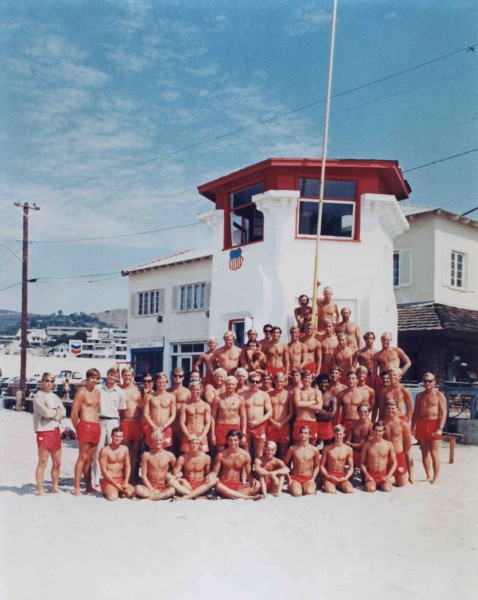By Dale Ghere, Special to the Independent
The pros and cons of permanent lifeguard towers have become a subject of debate in recent months. I thought a look back at the different kinds of towers used over the years would add some perspective to the discussion.
Main Beach From the very beginning, lifeguards at Main Beach used some kind of platform. From 1929 to 1934, their tower was a wood stand that stood about eight feet above the sand. The 1929 tower used an umbrella to provide shade for the two guards, but every tower thereafter had a roof.
The present Main Beach tower was moved from its original position at a corner gas station on Broadway and Coast Highway to its present position in 1935. This structure has served guards well for the past 62 years, though so many repairs have been made that there is probably little if any of the original structure remaining.
Towers for the coves

Divers’ Cove was the first cove to have guards, beginning in 1935. The first to hold the job were Curtis Burns and Bud Kerrigan, who worked six days a week for $75 a month, Kerrigan told me. About the same time guards were also dispatched to Woods Cove.
In 1937 Paul Schilling was the first guard assigned to Victoria Beach. In the ‘30s guards were paid for an eight-hour day, but were expected to get to the beach an hour early so they could pick up seaweed.
Large towers shielded the guards at Woods and Divers’ Cove. Victoria had a tall, covered platform that allowed the guard a good view of the beach. All of these towers were made of wood and were built in the sand.
I assume the storm surf of ‘38 and ‘39, which also destroyed the pier north of Main Beach, washed the large wooden towers away. After the ‘30s there are no more pictures of the original wooden towers. Neither could I find pictures of towers in the ‘40s. I recall a newspaper articles about the chief lifeguard complaining that the towers were consumed for firewood in winter.
Watermen Memories
Bob Lowell, who guarded Crescent Bay in 1944 and 1945, said the only qualification for the $5 a day job was how fast you could swim. Guards received no training in rescues or first aid, were expected to supply their own medical supplies and pick up trash and seaweed. “We were given a grey blanket to sit on and the rescue buoy was made of metal. It was very dangerous to use.
Anyone who wanted to be a lifeguard lined up in front of the Main Beach tower. When the captain said, “go,” you swam out around the buoy in front of the tower and back to the beach. The first eight back to the line were hired.”
Tom Morey, who worked as a guard at Balboa Bay Club in 1953, also was a guard for Laguna in the summer of 1954. A story in the Laguna Beach Post about Carl Mays’ alert rescue force included a photo of Morey sprawled asleep across the cramped podium of a tower at Thalia or Oak Streets.
Rod Riehl, who guarded for 20 years beginning in 1955, began at Divers’ Cove. He took a backrest and an umbrella to the beach because there was no tower. “We didn’t have a rescue tube. We just swam out to the victim, grabbed their arm and side stroked back to the beach.” Throughout the 40s and 50s almost all guards had at least a telephone on a post, which was buried in the sand to identify his position and give him communications with Main Beach.




